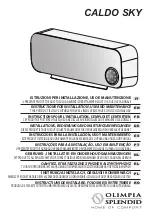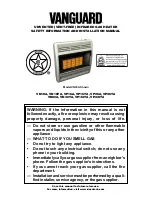
19
VENT PIPE PREPARATION
1.
INITIAL PREPARATION
A. Make sure the solvent cement you are planning to use is
designed for the speci
fi
c application you are attempting.
B. Know the physical and chemical characteristics and limitations
of the PVC and CPVC piping materials that you are about to
use.
C. Know the reputation of your manufacturer and their
products.
D. Know your own quali
fi
cations or those of your contractor. The
solvent welding technique of joining PVC and CPVC pipe is
a specialized skill just as any other pipe
fi
tting technique.
E. Closely supervise the installation and inspect the
fi
nished
job before start-up.
F.
Contact the manufacturer, supplier, or competent consulting
agency if you have any questions about the application or
installation of PVC and CPVC pipe.
G. Take the time and effort to do a professional job. Shortcuts
will only cause you problems and delays in start-up. By far,
the majority of failures in PVC and CPVC systems are the
result of shortcuts and/or improper joining techniques.
2.
SELECTION OF MATERIALS
• Cutting Device - Saw or Pipe Cutter
• Deburring Tool, Knife, File, or Beveling Machine (2" and above)
• Brush - Pure Bristle
• Rag - Cotton (Not Synthetic)
• Primer and Cleaner
• Solvent Cement - PVC for PVC Components and CPVC for CPVC
Components
• Containers - Metal or Glass to hold Primer and Cement. Select
the type of PVC or CPVC materials to be used on the basis of their
application with respect to chemical resistance, pressure rating,
temperature characteristics, etc.
• Insertion Tool - Helpful for larger diameter pipe and
fi
ttings 6 inches
(15.2 cm) and above.
PRIMER
It is recommended that Tetrahydrofuran (THF) be used to prepare the
surfaces of pipe and
fi
ttings for solvent welding. Do not use water,
rags, gasoline or any other substitutes for cleaning PVC or CPVC
surfaces. A chemical cleaner such as MEK may be used.
CEMENT
The cement should be a bodied cement of approximately 500 to
1600 centipoise viscosity containing 10-20% (by weight) virgin PVC
material solvated with tetrahydrofuran (THF). Small quantities of
dimethyl formamide (DMF) may be included to act as a retarding
agent to extend curing time. Select the proper cement; Schedule 40
cement should be used for Schedule 40 pipe. Never use all-purpose
cements, commercial glues and adhesives or ABS cement to join PVC
or CPVC pipe and
fi
ttings.
APPLICATORS
Select a suitable pure bristle type paint brush. Use a proper width brush
or roller to apply the primer and cement (see chart below). Speedy
application of cement is important due to its fast drying characteristics.
IMPORTANT NOTE: A dauber type applicator should only be used
on pipe sizes 2" and below. For larger diameter pipe, a brush or roller
must be used.
RECOMMENDED BRUSH* SIZE FOR PRIMER
AND CEMENT APPLICATIONS
Nominal Pipe
(IPS)
Size Brush Width
(INS.)
2
1-1/2
3
1-1/2 - 2-1/2
*USE ONLY NATURAL BRISTLE
3
.
MAKING THE JOINT
A. Cutting
Pipe must be squarely cut to allow for the proper interfacing of the
pipe end and the
fi
tting socket bottom. This can be accomplished
with a miter box saw or wheel type cutter. Wheel type cutters are
not generally recommended for larger diameters since they tend
to
fl
are the corner of the pipe end. If this type of cutter is used, the
fl
are on the end must be completely removed.
NOTE: Power saws should be speci
fi
cally designed to cut plastic
pipe.
STEP A
Содержание 185244-004
Страница 3: ...3 GENERAL SAFETY ...
Страница 21: ...21 ...
Страница 29: ...29 ...
Страница 32: ...32 500 Tennessee Waltz Parkway Ashland City TN 37015 www statewaterheaters com ...














































